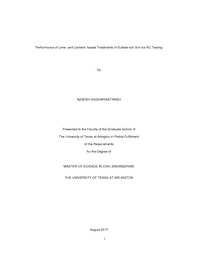
ATTENTION: The works hosted here are being migrated to a new repository that will consolidate resources, improve discoverability, and better show UTA's research impact on the global community. We will update authors as the migration progresses. Please see MavMatrix for more information.
Show simple item record
| dc.contributor.advisor | Hoyos, Laureano | |
| dc.creator | Asghariastaneh, Azadeh | |
| dc.date.accessioned | 2017-10-02T14:23:33Z | |
| dc.date.available | 2017-10-02T14:23:33Z | |
| dc.date.created | 2017-08 | |
| dc.date.issued | 2017-09-20 | |
| dc.date.submitted | August 2017 | |
| dc.identifier.uri | http://hdl.handle.net/10106/26972 | |
| dc.description.abstract | Chemical treatment of expansive sulfate-rich soils, particularly lime- and cement-based methods, had been rather popular due to their relatively low cost and ready availability. However, over the last few decades, extensively documented pavement failures, mainly caused by excessive heaving and/or shrinkage of lime- and cement-treated subgrades with moderate-to-high sulfate content, have led to thorough investigations to assess the actual feasibility and effectiveness of calcium based stabilizers in sulfate-rich soils. Studies have concluded, with solid experimental evidence, that the calcium present in the chemical stabilizers react with the sulfate and alumina of the treated soil to form Ettringite, an expansive mineral that has detrimental effects on the overall performance of the treated soil. Most of these studies have mainly focused on detrimental effects of lime- and cement-based treatment methods in terms of Atterberg limits, swell-shrink potential, and unconfined compressive strength.
The present study is aimed at gaining valuable insight into the effects of lime- and cement-based treatment methods on stiffness of sulfate-rich soils, namely, shear modulus and damping, which are fundamental properties in the analysis and design of pavement infrastructure. To achieve this goal, a thorough series of resonant column (RC) tests was conducted on several chemically stabilized specimens of high-plasticity, sulfate-rich expansive clay from Sherman, Texas. Test results were analyzed to assess the influence of lime- and cement-based stabilizer dosage, curing time, and confining pressure on the shear modulus and damping of the treated soil, including 8%lime + 2% fly ash, 6% lime + 4% fly ash, and 3% cement + 2% fly ash. In general, results show a detrimental effect of all treatment methods on soil stiffness, only rendering 6% lime + 4% fly ash as a potentially viable treatment method with curing time longer than 14 days. | |
| dc.format.mimetype | application/pdf | |
| dc.language.iso | en_US | |
| dc.subject | Sulfate | |
| dc.subject | Heave | |
| dc.subject | Cement | |
| dc.subject | Lime | |
| dc.subject | Fly ash | |
| dc.subject | Proximitor RC test | |
| dc.title | Performance of Lime- and Cement- based Treatments of Sulfate-rich Soil via RC Testing | |
| dc.type | Thesis | |
| dc.contributor.committeeMember | Kermanshachi, Sharareh | |
| dc.degree.department | Civil Engineering | |
| dc.degree.name | Master of Science in Civil Engineering | |
| dc.date.updated | 2017-10-02T14:24:37Z | |
| thesis.degree.department | Civil Engineering | |
| thesis.degree.grantor | The University of Texas at Arlington | |
| thesis.degree.level | Masters | |
| thesis.degree.name | Master of Science in Civil Engineering | |
| dc.type.material | text | |
Files in this item
- Name:
- ASGHARIASTANEH-THESIS-2017.pdf
- Size:
- 4.486Mb
- Format:
- PDF
This item appears in the following Collection(s)
Show simple item record


